DAM Event Listener
Cloud Edition only
This project is designed for Product 360 Cloud Edition customers only. (On premise customers can use this project and modify it to their needs, but it is not under Informatica's support! )
Preface
This BPM (AVOS) project enables Product 360 Cloud Edition customer's to create derivatives for Digital Assets image files via converting them with ImageMagick. This functionality works only for the Asset Provider HMM, which is the default in the Cloud Edition settings.
Table of Contents
Prerequisites
The DAM-event-listener also supports the auto assignment functionality over the message queue communication. Therefor the messaging service of ActiveVOS must be configured. Please reach out to the Installation and Operation guide for the following areas:
Installation of ActiveVOS with ActiveMQ support and configuration of queues in ActiveVOS (Note: ActiveVOS version 9.2.4.6 is a prerequisite for queue based interactions between Product 360 and ActiveVOS)
Installation
You have to deploy these resources:
InfaResources.bpr
DAM_Tools.bpr
DAM_Resources.bpr
with the BPM (AVOS) console.
Also it is possible that you deploy the workflows with your BPM designer. The resources of the projects are in the zip files:
InfaResources.zip
DAM_Tools.zip
DAM_Resources.zip
Configuration
The base configuration of the DAM Event Listener, which is the base for creating derivatives, must be defined in the BPM URN mappings. Therefore you have to define the following mappings in the BPM console.
These settings will be done from Informatica OPS team when the customer request it.
URN mappings for AWS
|
URN |
URL |
Mand. |
Description |
|
urn:p360.aws.s3.bucket.name |
pim-example-bucket |
Yes |
S3 bucket name of the customer's environment |
|
urn:p360.dam.max.threads |
2 |
No |
Maximum number of parallel ActiveVOS threads while creating new assets |
|
urn:p360.dam.resource.project |
DAM_Resources |
No |
Name of the resource project where the customer can define the derivatives |
|
urn:p360.dam.aws.public.path |
/qa/P360Server/public/ |
No |
Public path on the S3 bucket, where the derivatives can be pushed |
|
urn:p360.dam.aws.public.url |
https://pim-iw2022-bucket.s3.amazonaws.com/qa/P360Server/public/ |
No |
Url to the public S3 bucket |
URN mappings for Azure
|
URN |
URL |
Mand. |
Description |
|
urn:p360.dam.max.threads |
2 |
No |
Maximum number of parallel AciveVOS threads while creating new assets |
|
urn:p360.dam.resource.project |
DAM_Resources |
No |
Name of the resource project where the customer can define the derivatives |
|
urn:p360.dam.azure.public.path |
/opt/informatica/shares/S3_PUBLIC/ |
No |
Public path on the public blob storage, where the derivatives can be pushed |
|
urn:p360.dam.azure.public.url |
https://voldemononprodsa.blob.core.windows.net/pim-voldemo-customer-container-nonprod-public/ |
No |
Url to the public blob storage |
Context properties for the messaging service
These 3 required context properties in the messaging service ActiveMQ have to be created. You can navigate to the service in the ActiveVOS console.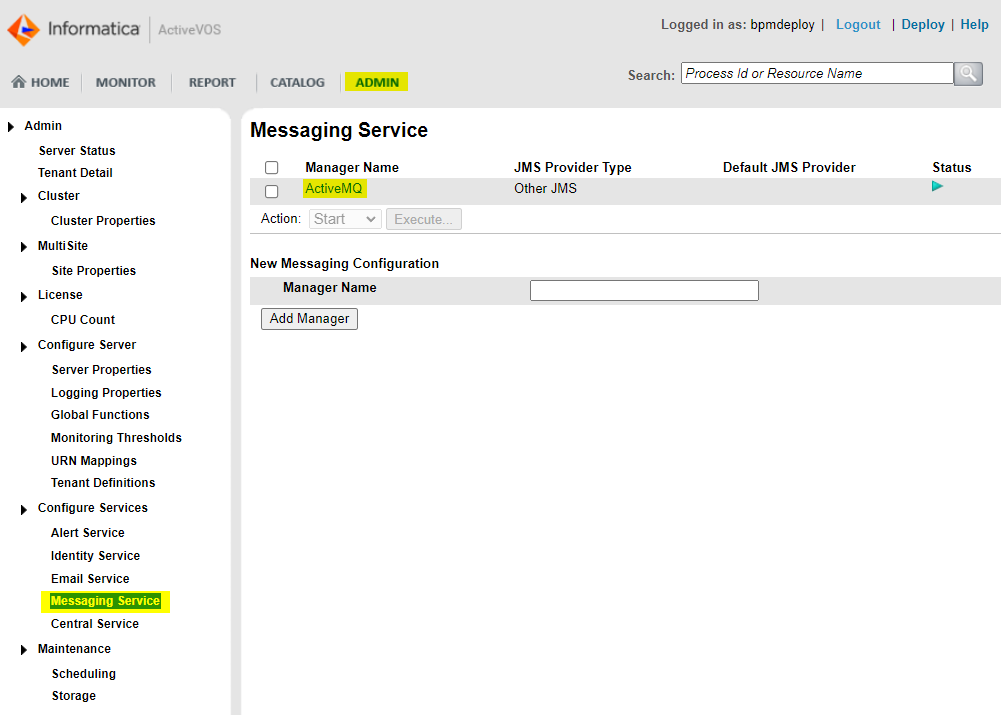
|
Name |
Value |
|
queue.JNDI_P360_DAM_ASSIGNMENT |
heiler.hmm.backend.event.assignment |
|
queue.JNDI_P360_DAM |
heiler.hmm.backend.event |
|
queue.JNDI_P360_DAM_MODIFIED |
heiler.hmm.backend.event.assetModified |
Database JNDI
ActiveVOS must be able to connect to the DAM related tables on the database, therefor you have to create an additional JNDI entry "<Resource name="jdbc/DAM" auth="Container" type="javax.sql.DataSource"" to the HMM tables, in the configuration file active-bpel.xml.
Schedule the maintenance job
The DAM-Event-Listener is implemented as an endless loop. The workflow has to be started one time via creating a scheduled maintenance job via the ActiveVOS console.
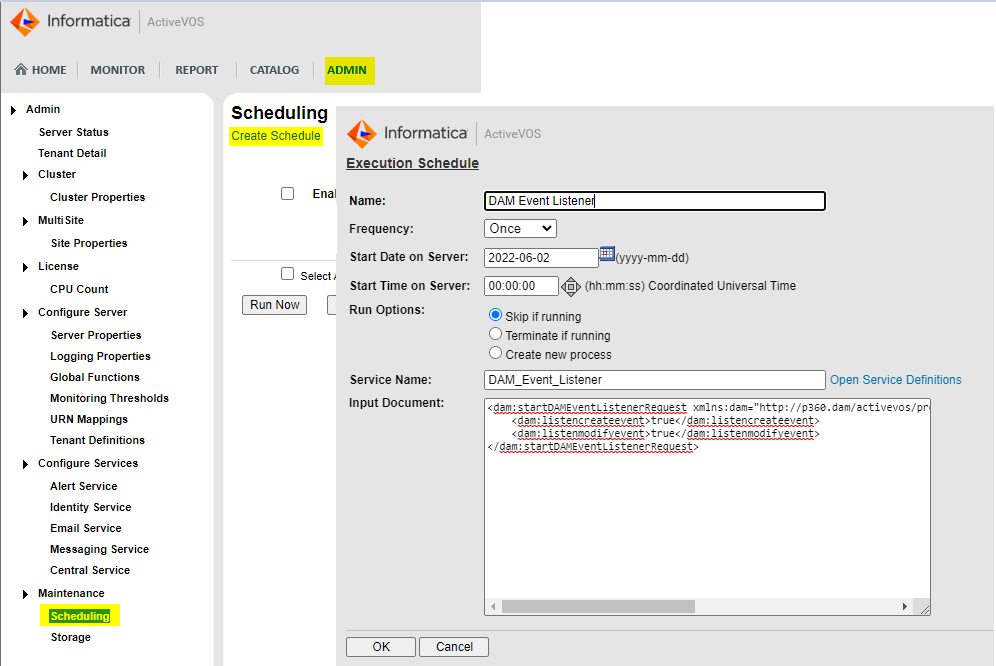
Job settings
|
Key |
Value |
|
Name |
DAM_Event_Listener |
|
Frequency |
Once |
|
Start Date on Server |
Do not modify |
|
Start Time on Server |
Do not modify |
|
Run Options |
Skip if running |
|
Service Name |
DAM_Event_Listener |
|
Input Document |
<dam:startDAMEventListenerRequest xmlns:dam="http://p360.dam/activevos/process/DamEventListener" xmlns:soap="http://www.w3.org/2003/05/soap-envelope"> |
Defining Derivatives
Derivatives must be defined with the help of a xml definition, which is located in the resource project which is defined in the URN mappings of ActiveVOS.
ImageMagick
Only conversions for images with the command line tool convert from ImageMagick are supported!

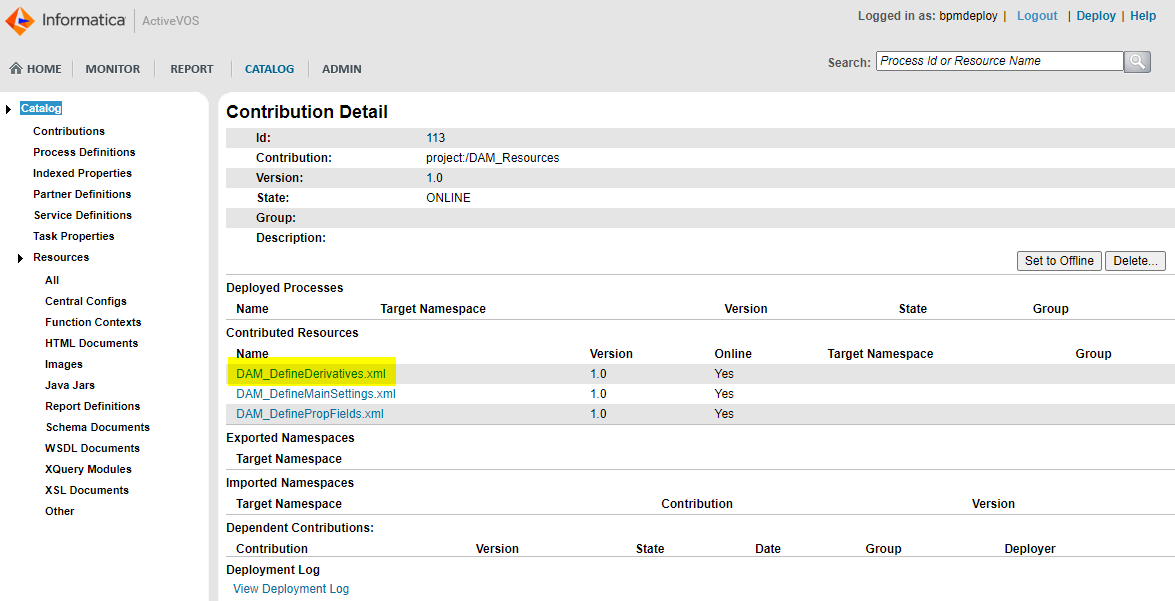
If you want to make some modifications you have to click on the link, make your modifications and click on update.
The configuration file DAM_DefineDerivatives.xml
<das:dataAccessResponse xmlns:das="http://schemas.active-endpoints.com/data-access/2010/04/data-access.xsd" statementId="string"><!-- Description of defining DAM property fields Tag: DEV_ID: Mandatory number of the derivate. Allowed values between 1 and 100 Tag: DEV_NAME: Mandatory description of the derivate 50 characters at maximum. If this value is empty the derivative with this id will be deleted! Tag: DEV_EXT: Mandatory extension of the derivate 10 characters at maximum. Tag: DEV_CONVERT_PARAMS: Optional parameters for the ImageMagick command convert. If this value is set a derivative will be created otherwise not! Tag: DEV_PUBLIC: Optional parameter which defines whether the derivative will be copied into the public space. Valid values: Yes, No, 1,0 Tag: DEV_PROP_FIELD_ID: Optional parameter defines whether the public path will be pushed into a property field. Allowed values between 1 and 100 --> <!-- Examples <das:row> <DEV_ID>1</DEV_ID> <DEV_NAME>Jpeg 70x70</DEV_NAME> <DEV_EXT>.jpg</DEV_EXT> <DEV_CONVERT_PARAMS>-alpha off -flatten -strip -antialias -quality 80 -resize 70x70 -background white -gravity center -extent 70x70 -density 72x72 -colorspace sRGB "%1"[0] "%2"</DEV_CONVERT_PARAMS> <DEV_PUBLIC>YES</DEV_PUBLIC> <DEV_PUBLIC_PROP_FIELD_ID>81</DEV_PUBLIC_PROP_FIELD_ID> </das:row> <das:row> <DEV_ID>2</DEV_ID> <DEV_NAME>Jpeg 300x300</DEV_NAME> <DEV_EXT>.jpg</DEV_EXT> <DEV_CONVERT_PARAMS>-alpha off -flatten -strip -antialias -quality 80 -resize 300x300 -background white -gravity center -extent 300x300 -density 72x72 -colorspace sRGB "%1"[0] "%2"</DEV_CONVERT_PARAMS> <DEV_PUBLIC>YES</DEV_PUBLIC> <DEV_PUBLIC_PROP_FIELD_ID>82</DEV_PUBLIC_PROP_FIELD_ID> </das:row> <das:row> <DEV_ID>3</DEV_ID> <DEV_NAME>PNG 1024x1024</DEV_NAME> <DEV_EXT>.png</DEV_EXT> <DEV_CONVERT_PARAMS>-alpha off -flatten -strip -antialias -quality 80 -resize 1024x1024 -background white -gravity center -extent 1024x1024 -density 72x72 -colorspace sRGB "%1"[0] "%2"</DEV_CONVERT_PARAMS> <DEV_PUBLIC>YES</DEV_PUBLIC> <DEV_PUBLIC_PROP_FIELD_ID>83</DEV_PUBLIC_PROP_FIELD_ID> </das:row> --></das:dataAccessResponse> Example define a 70 pixel RGB Jpeg as derivative
<das:dataAccessResponse xmlns:das="http://schemas.active-endpoints.com/data-access/2010/04/data-access.xsd" statementId="string"> <das:row> <DEV_ID>1</DEV_ID> <DEV_NAME>Jpeg 70x70</DEV_NAME> <DEV_EXT>.jpg</DEV_EXT> <DEV_CONVERT_PARAMS>-alpha off -flatten -strip -antialias -quality 80 -resize 70x70 -background white -gravity center -extent 70x70 -density 72x72 -colorspace sRGB "%1"[0] "%2"</DEV_CONVERT_PARAMS> <DEV_PUBLIC>NO</DEV_PUBLIC> <DEV_PUBLIC_PROP_FIELD_ID></DEV_PUBLIC_PROP_FIELD_ID> </das:row></das:dataAccessResponse> |
Key |
Value |
Description |
|
DEV_ID |
1 |
Unique identifier of the derivate |
|
DEV_NAME |
Jpeg 70x70 |
Name of the derivative |
|
DEV_EXT |
.jpg |
New extension of the converted image |
|
DEV_CONVERT_PARAMS |
-alpha off -flatten -strip -antialias -quality 80 -resize 70x70 -background white -gravity center -extent 70x70 -density 72x72 -colorspace sRGB "%1"[0] "%2" |
Command line parameters for the command convert to create a jpeg derivative with the dimension 70x70 in the colorspace RGB |
|
DEV_PUBLIC |
NO |
This tag defines whether the derivative will also pushed to a public accessible blob storage. Please create a CTP ticket to create this storage. |
|
DEV_PUBLIC_PROP_FIELD_ID |
empty |
The public URL to the derivative will be stored in this property field, when DEV_PUBLIC is YES. |
Default states
By default the DAM-Event-Listener workflow will create 5 states.
|
Id |
Name |
|
0 |
*No status defined* |
|
1 |
Create derivatives again |
|
2 |
Derivatives successfully created |
|
3 |
Error while creating derivatives |
|
4 |
No derivative definition for this type |
This state will be stored directly on the Media Asset.
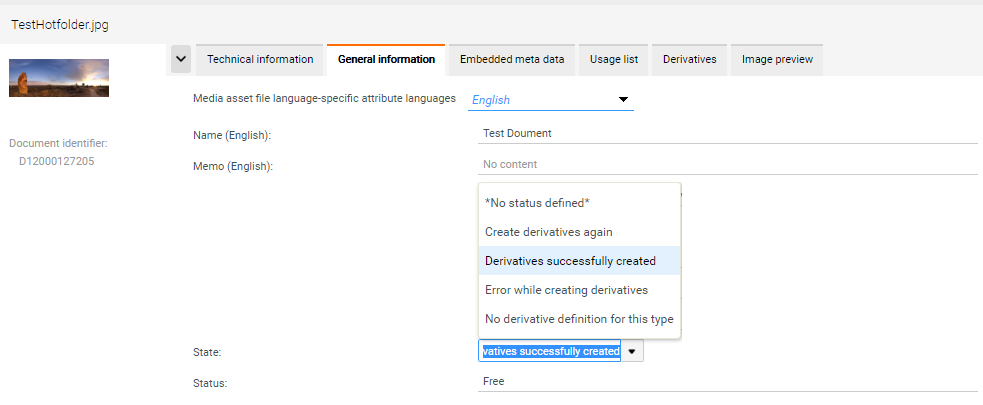
Start the DAM Event Listener
The DAM Event Listener can be started in the ActiveVOS console.
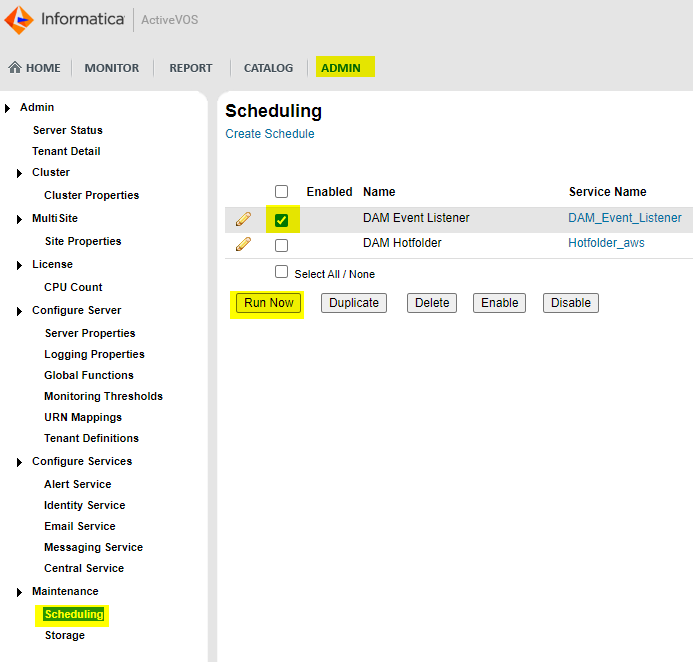
Now the process should run. You can check this as well in the ActiveVOS console.

Processes
You should see these processes.
Verification
Let's assume you defined the derivative with the Identifier 1 in your DAM_DefineDerivativel.xml definition.
Login into you Product 360 web application
Click on Media

Search an asset
Go to the General information tab in the details section and set the state to Create derivatives again
Go to the Derivatives tab and refresh the page. If everything works as expected you should see the derivative

If the derivative was not created successfully, please check the ActiveVOS processes
